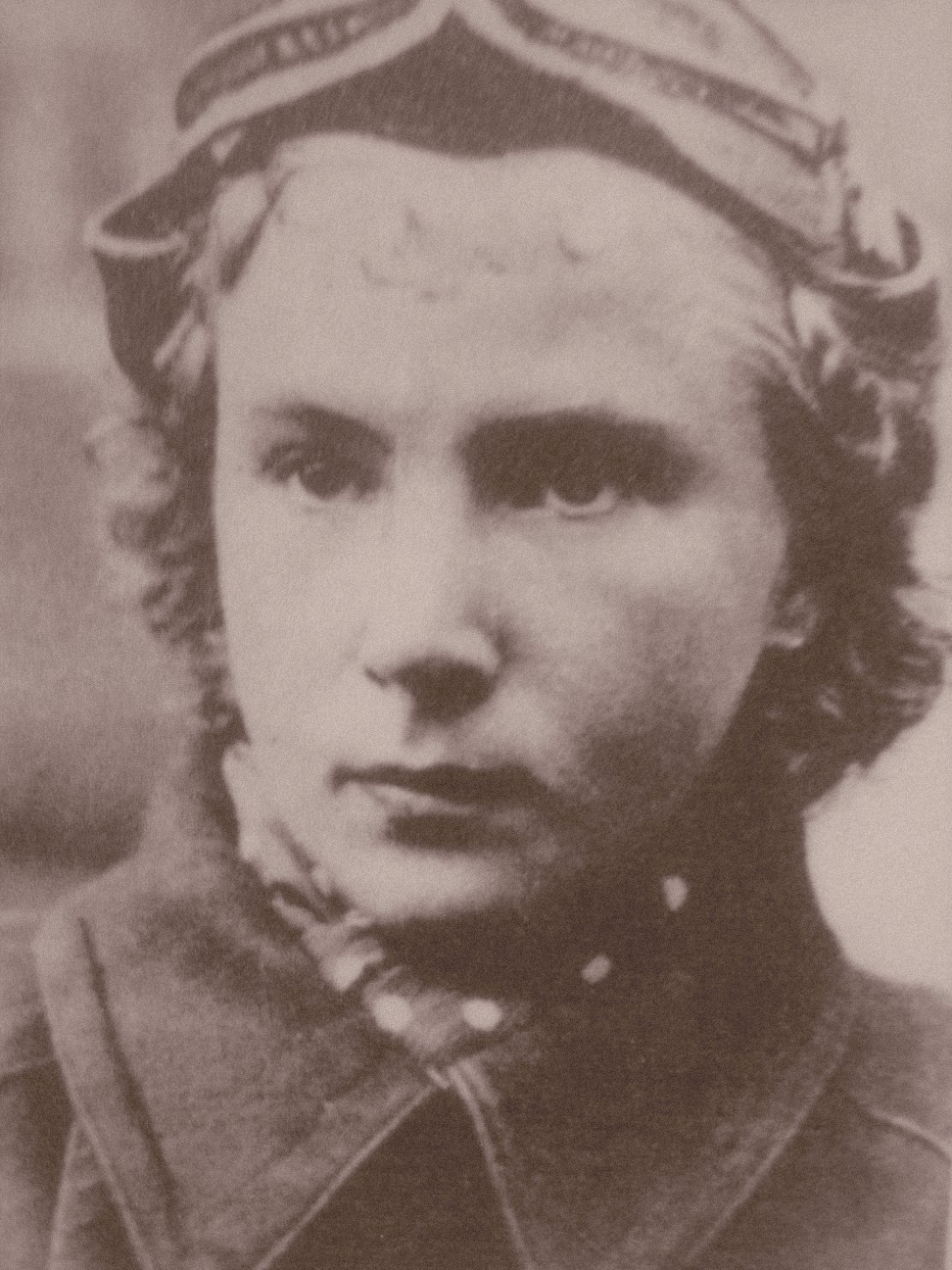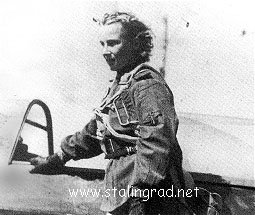Lilya
Vladimirovna Litvyak
.
The
white rose of Stalingrad

Lilya was born in Moscow in August
18, 1921. Lilya was her nickname, as her actual name
was Liliya. She was regarded by
all as a "strikingly beautiful woman", which helped earn her
public appreciation and, added
to her success as a fighter pilot, served the propaganda ministry
well.
She began her service in the all-woman
586th IAP, where she flew mostly defense missions
from January to August 1942. In
August she was posted to "male" squadrons because of her
merits. The first was the 286th
Fighter Division (IAD), then to the 437 IAP, which had
recently been equipped with the
new Lavochkin La-5. With this unit she got her first 2 air
victories in September 13, 1943.
She was sent as an attachment to the female flight of the
287 IAD, and served briefly in
the 9th Guards IAP.
In the end of January, 1943,
she was transferred to the 296th along with 2 other skilled
women fighter pilots. On February
17, 1943, she was awarded the Order of the Red
Banner. Two days later she was
promoted to Junior Lieutenant and soon after to Senior
Lieutenant.
On each side of her YaK-1's cockpit
she painted a white lily, often confused for a
rose hence the nickname. She was
so fond of flowers, that she often picked wildflowers
and carried them aloft on her missions.
According to her mechanic, Inna Pasportnikova, she
had a postcard with yellow roses
in her instrument panel. The white rose on the fuselage
became famous among the Germans,
who knew better than to try to dogfight the familiar
YaK-1, and usually tried to make
good their escape before Litvyak got too close.
Litvyak was injured 3 times during
her combat tour. All three injuries occured during the
Spring and Summer of 1943, a period
of intense combat activity. The first time was on
March 15, the same day that she
shot down a Junkers Ju-88 bomber, but got hit by their
escorting Me-109s (she continued
to fly and bagged another Ju-88!). She managed to land
at her base, and passed out and
she remained in a hospital until May.
When she came back, the 296th IAP
had been renamed the 73 Guards IAP for their
exploits in battle. She was wounded
again in combat in July 16 and 18 (the death-date
of her comrade Katya Budanova).
Both times she landed in German-ocuppied territory,
but got back to base on foot the
first time, and was rescued by another fighter pilot who
landed after her the second.
She was repeatedly successful in
flying missions, although was finally killed while escorting
a unit of Shturmoviks returning
from an attack in August 1, 1943. Because of her notoriety
amongst the Germans, eight Messerschmitt
Me-109's concentrated solely on Lilya's YaK-1,
and it took all eight of them to
finally shoot down the "White Rose of Stalingrad". Her body and
aircraft were not found during
the war, but a marble monument, with 12 gold stars—one for
each enemy plane that she had shot
down—was erected in her memory in Krasy Luch, in the
Donetsk region. Litvyak had completed
168 missions, and had 3 shared victories in addition to
her personal twelve. She was 22
years old when she died.
When war in the Soviet Union broke out in 1941 Lilya Litvyak was serving as
a flight instructor, having secretly begun to learn to fly with the local
air club at the young age of 14. Training 45 students before the war began,
Litvyak applied repeatedly for military duty when the war started and at the
last minute she heard about a women's group being formed by Marina Roskova.
Litvyak went for an interview and was accepted.
In training Lilya outshone her male trainers and scored above the other
trainees. During a practice dogfight in her slow 100 M.P.H. PO - 2 trainer
Lilya shot down her instructor. Heading back to base Lilya performed a
flamboyant manoeuvre that was later to become her trademark. Swooping low
over the hangers, she soared up into a victory roll, then landed. Upon
completion of her advanced training Lilya, along with the other trainees
formed the 586th (all woman) Fighter Regiment flying the Yakovlev Yak-1.
In September 1942 one squadron from this regiment was detached to the front
at Stalingrad. Lilya, along with another seven woman pilots, was included.
According to official documents, on the 13th September Litvyak scored her
first two victories, becoming the first woman in the world to shoot down an
enemy aircraft. Lilya was wingman to the regimental commander and, after
spotting three Junkers Ju-88's to the side of a bigger group of bombers, the
leader attacked and Lilya followed. She attacked with so much enthusiasm
that the bombers scattered and dropped their bombs. Taking advantage of
this, her leader shot down one Ju 88, while Lilya destroyed a second.
Lilya then spotted her friend, Raya Belyaeva, attacking a Messerschmitt Bf
109 until she finally ran out of ammunition. Lilya engaged the German
fighter and shot it down. Later Lilya learned that the German she had shot
down was a highly decorated fighter ace. This was a great achievement,
almost unequalled for a new pilot at the front, two kills in one day.
The women fighter pilots had to prove their abilities in order to earn the
respect of men. This was made even more difficult for Lilya as she had
blonde hair, grey eyes and was beautiful.
Tragically Lilya Litvyak was shot down at the age of 21, during one of the
most horrendous air battles of the war. Lilya's mission that day was on the
front line, looking for enemy bombers and ten miles from the front they ran
into a large group. Ivan Borisenko, who was flying with Lilya on that
mission wrote later to Vera Tilomerva, the commissar of the women's fighter
regiment: "Lilya just didn't see the Messerschmitt 109's flying cover for
the German bombers. A pair of them dived on her and when she did see them
she turned to meet them. Then they all disappeared behind a cloud." Through
a gap in the cloud he saw Lilya's luck had run out, no one saw her aircraft
crash.
They say the white rose on her Yak had drawn her killers to her. The morning
before her flight she found some wild flowers and pinned a little bunch to
the side of the instrument panel. Those who loved her like to think that at
the end Lieutenant Litvyak's last glimpse was of the flowers in the corner
of her cockpit.
Lilya was a seasoned fighter ace and flight commander at the time of her
death, with 12 personal kills and three shared kills. Sadly she did not
receive the honours due to her until many years after the war, as her body
could not be found.
The Search for Lilya Litvyak
Reina Pennington is an American author who has long been intrigued with the
story of Lilya Litvyak and the role of the woman fighter pilot. In 1994 she
wrote an article entitled Wings, Woman & War for the NASM's Air & Space
Magazine on these subjects. During her research she found that Litvyak's
mechanic, Inna Pasportnikova, was long tormented by the question of how to
prove that Lilya was killed heroically and not taken into captivity. Her
quest lasted nearly 50 years. From the above article the following time line
is taken:
Mid August 1943:
Litvyak's regiment, the 73rd Guards Fighter Aviation Regiment nominates her
for the Hero of the Soviet Union medal, but the award was refused as her
body has never been found.
Summer 1946:
People search for Litvyak's aircraft near the spot where she disappeared. It
is not found.
1946 - 1968:
Through correspondence and media Inna Pasportnikova establishes contact with
several groups of school children Pioneers who live in the Dombass region.
These groups offer to help search for unmarked graves, aircraft wreckage,
and other war relics that they dig by hand.
1968:
A newspaper wants to revive the appeal to award Litvyak with the Hero of the
Soviet Union medal. Request denied, body was still not found.
1971:
Inna Pasportnikova and Lilyas' family search with the pioneers. In all, more
than 90 aircraft are found as well as the remains of many unidentified
pilots.
1979:
The pioneers find a crash site on a farm near Dmitrievka and are told that a
woman pilot had been buried there but then moved in July 1969 to a common
grave. The body is exhumed. The doctors can tell only that the pilot had
been a short woman and had sustained a head injury.
March 31, 1986:
Central Archives of the Ministry of Defense confirms that the woman pilot
who crashed near Dmitrievka had to be Litvyak.
1988:
Litvyak's name is placed on the common grave. Her records are changed from
missing without trace to killed in action, 1 August 1943.
May 5, 1990:
Chairman Mikhail Gorbachev signs a document conferring the title of Hero of
the Soviet Union on Lilya Litvyak.

|